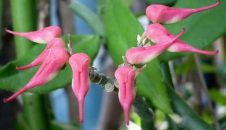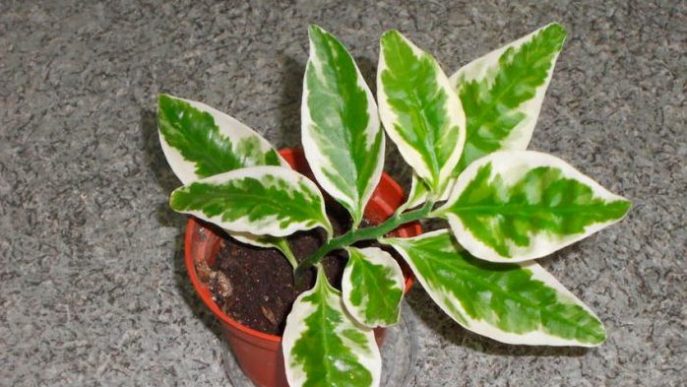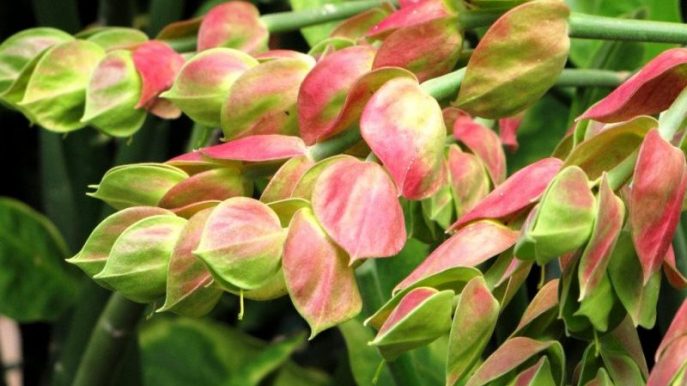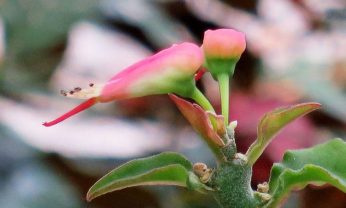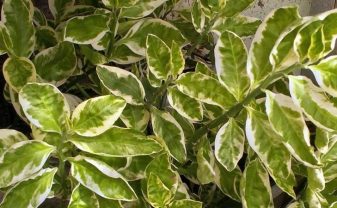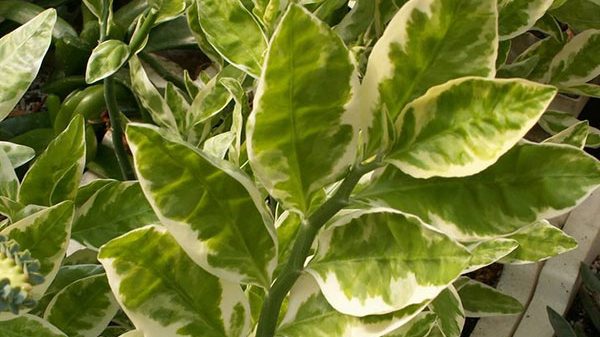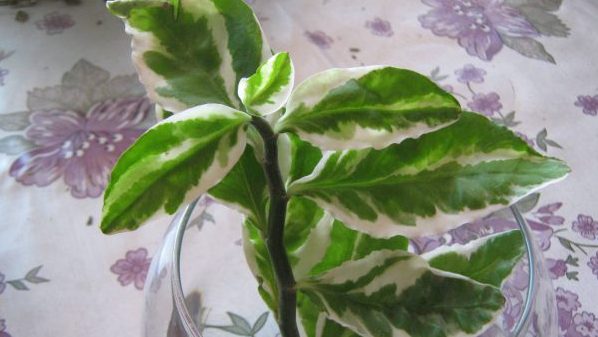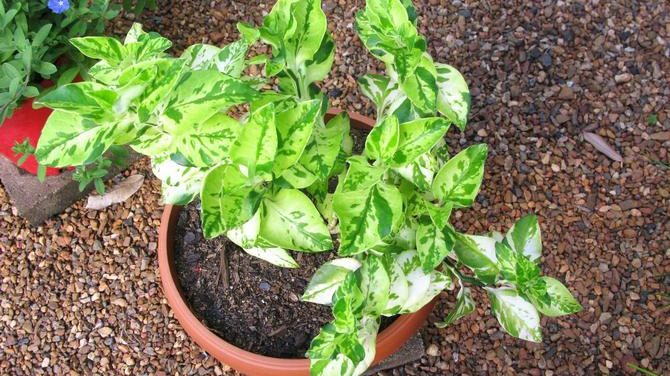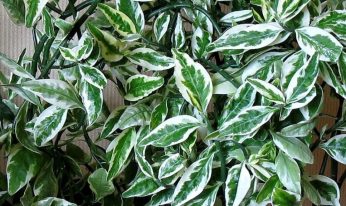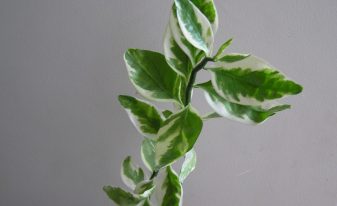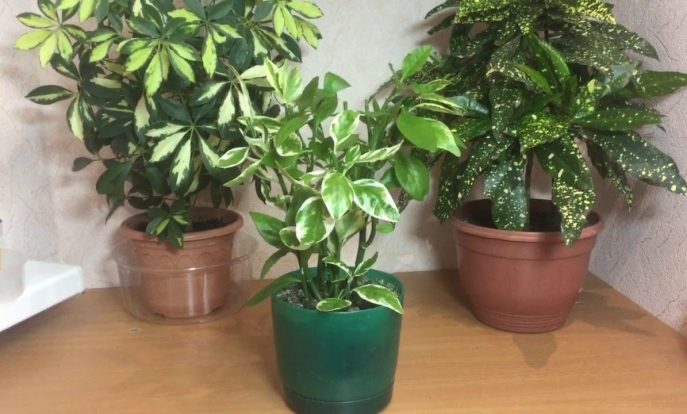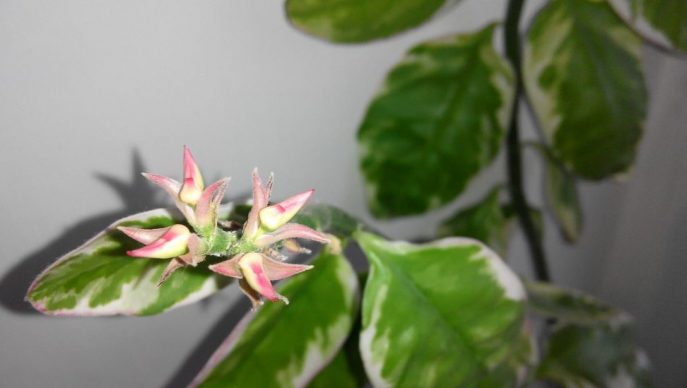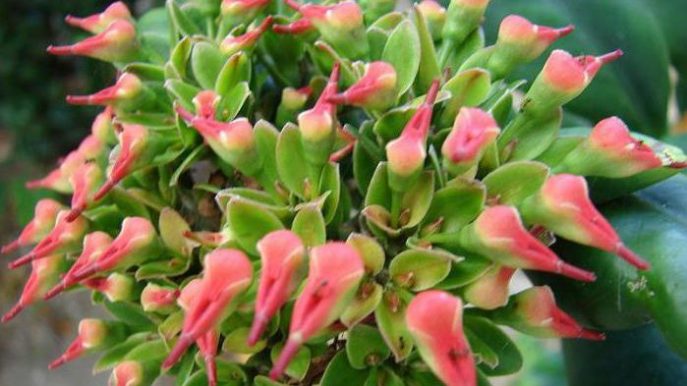An extraordinarily interesting plant with miniature flowers - slippers and dense leaves. Thanks to its decorative qualities, it got its name from the Greek "pedilot" shoe, shoe, "anthos" - a flower. We grow room Pedilanthus. Home care is simple, but has some features.
Material Content:
Varieties and types of plants
The historical homeland of culture is both the American continent, where it grows in nature. We grow it in indoor floriculture. For most of the year it is used as an ornamental foliage plant with a compact crown and erect stems. In the lower part, the leaves fall, forming a stepped form, which is why the plant was awarded the names "Jacob's Ladder" and "Devil's Ridge". A leaf blade of regular cherry shape has a length of 10 cm and a width of 5 cm. A miniature flower looks like an elegant shoe with a bright red hue. The inflorescence includes 5 to 7 buds, blooming alternately in December - January.
There are such types of plants:
- Large-fruited pedilanthus differs from other species in the complete absence of leaves, or rather, their modification to small scales. The gray-green, watery shoots are typical of the succulents to which it belongs. Groups of flowers form at the ends of the stems.
- Coalomanian pedilanthus looks like a small sprawling tree or bush. Of all species, it has the largest bright orange inflorescences. The advantage of the plant is to tolerate drought. When the lack of moisture is especially palpable, the culture discards leaves.This unpretentiousness in care is important for those gardeners who can not devote much time to pets.
- Pedilanthus titimaloid - a species that changes the color of leaves in different lighting conditions. This property is used by breeders to produce varieties with stripes at the edges. Their color is white or pink.
- Pedilanthus Finca can be distinguished by bright green, wavy leaves, at the ends of wavy shoots. The stems are collected in dense bunches.
- Shportsovy pedilanthus is the largest among the brethren. A small tree grows to three meters. The branches are dark green, almost black, slightly refracted at the internodes.
All species are different, and without knowing it is difficult to guess that the plants belong to the same botanical genus.
Pedilanthus, cultivation features
When planning to purchase a plant, it is worth paying attention to its toxicity. Like many members of the Euphorbia family, it contains toxic substances.
If there are kids or pets in the house, it is better to refuse pedilanthus.
But, it is indispensable where there is no way to devote a lot of time to leaving. It will not be a hassle if you choose the right place, provide the right temperature and periodic watering. It is important to consider that the plant does not tolerate drafts. Flowering in the winter period obligates to clean it to rest in time.
Read more on how to create the optimal environment for the successful growth of pedilanthus.
Home Care
A good solution is to place the plant on the northeast windowsill. Then, in the morning it will be lit by direct sunlight, and in the afternoon it will be shaded. He prefers a lot of light, but suffers in the sun. If it is on the south side, then in the summer heat you need to provide protection from scorching rays. Accordingly, in the north, from a lack of light, the stems become long and thin, the leaves are pale. For example, in such conditions, the titylmaloid pedilanthus loses its decorative stripes, and the leaves become not expressively green. It is this species that is grown most often.
Soil requirements
The plant substrate is a light nutrient mixture that provides good aeration and drainage. It is composed by combining:
- Sheet earth - 2 hours,
- Soddy soil - 1 h.,
- Coarse river sand - 1 h.
For the cultivation of pedilanthus, it is better to select containers of light color that reflect the sun's rays.
Optimal conditions
The temperature in the summer is + 220 - + 250. In winter, it is advisable to maintain an average of + 180 and prevent sudden changes and turbulence. The wind tunnel is especially dangerous, so you should not position the plant where a strong draft is possible.
To air humidity does not impose special requirements. Although, it tolerates short-term drought better than prolonged rainy weather.
In winter, keep away from heaters and stationary radiators.
In summer, pedilanthus feels good on an open balcony if it is protected from heat and rain.
Watering a plant
Ideal when the substrate is kept wet. If there is too much water, the roots will rot. With rare watering, from the differences in dryness and waterlogging, the plant loses its decorativeness. During irrigation, moisture should completely moisten the entire lump of soil in the pot and appear in the pan. Excess water must be poured.
In winter, watering the pedilanthus is carried out less often, preventing the drying of the soil mixture.
Fertilizing and fertilizers
Mineral compounds are used for succulents. They have a minimal nitrogen content. Excess of this element causes excessive growth of green mass, which is not able to feed a weak root system. From which the plant dies.
When feeding, it is important to follow these recommendations:
- Fertilizers should be applied from April to October and canceled if the daylight hours are reduced in the cold season.
- Not more than once a month.
- Only after watering.
- In the morning or evening.
Trimming
Correction of the shape of the bush is carried out for two purposes:
- For branching the crown when the ends of the shoots are shortened. This will happen as a signal to the germination of the lateral buds.
- So that the plant does not grow too fast to delay the transplant.
Trimming is carried out in the following order:
- A sharp garden knife cut off the shoot on the internodes.
- Blot the milk juice with a paper towel.
- The incision is sprinkled with powdered activated carbon.
In very large specimens, some branches are removed completely to the stem.
The optimal period is the end of winter, the beginning of March.
How to transplant
The main type of transplant is transshipment, when a plant with a lump of substrate is moved into larger dishes. The diameter of the new container should be no less than the height of the crown, the depth 2 times the size of the root system with soil.
When transshipment, drainage material is poured to the bottom of the pot, with a layer of 3-5 cm. This allows you to remove excess water from the roots, which prevents decay.
The procedure is best done in the spring.
Pedilanthus reproduction
Cropped shoots do not need to be thrown away, they are excellent material for obtaining new plants.
- For rooting, cuttings are formed with a length of 8 to 10 cm, maintaining 3 to 4 internodes.
- On the lower part, which is placed in the substrate, leaves are removed.
- The juice that appeared on the slices is washed with warm water and left to dry for a day.
- Before planting, the lower edge of the cuttings is pollinated with a root, for example, “Kornevin” and placed in wet sand or vermiculite.
- Cover with plastic wrap or a special lid. It is important to ensure that the leaves do not touch the shelter, this increases the area of evaporation of moisture and leads to decay.
Survival takes place at a temperature of + 220 - + 250, on average, after 15 - 25 days. At this time, maintain soil moisture by spraying the cuttings and substrate. Do not allow prolonged condensation; ventilate the landing daily.
Pest and Disease Control
Often, gardeners wonder where the pathogens came from if they purchased a special substrate for succulents. Unfortunately, the presence of insects and pathogens is not excluded even in purchased soil.
For prophylaxis, 2 weeks before planting, EM preparations are introduced into the soil mixture. These are effective microorganisms that inhibit the growth of fungal diseases.
If nevertheless the pedilanthus is covered with white or gray coating, it is sprayed with a fungicide for indoor plants, for example, “Skor”.
Pests dangerous to pedilanthus are aphids and whiteflies. They begin to fight with them, washing the plant with warm water, manually removing insects. If the mechanical method does not help, the plant is treated with an insecticide.
Please note that work must not be carried out indoors. The containers are carried out to the street, where there are no people and animals.
Why pedilanthus does not bloom, leaves fall
For bright and dense inflorescences, good nutrition, watering and adequate lighting are necessary. If one of these conditions is violated, flowers will not form. Also, the plant will not bloom in the draft. For the same reason, it reacts like stress by dropping leaves.
Yellowing and falling occurs if you experience it with differences in drought and waterlogging. That is, pour a large amount of water into the container after a long break in irrigation.
Succulent does not like too fertile soil; tender roots rot in it, up to the complete death of the plant.
Due to unpretentiousness, pedilanthus is very popular in home floriculture and for landscaping large rooms
Taking into account its botanical features, and following the simple rules of care, it is easy to achieve its maximum decorative effect.


